Note: This post contains affiliate links. As a Skillshare Affiliate and Amazon Associate I get commissions for purchases/signups made through links in this post.
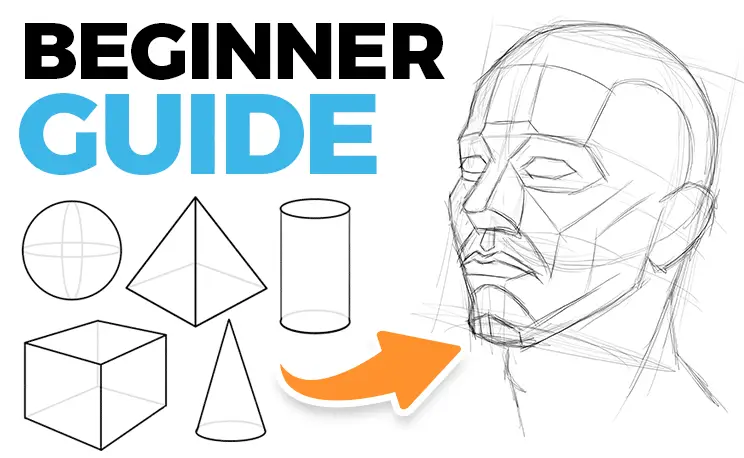
If you are a beginner artist your goal probably is to learn drawing fast. You are highly motivated, willing to invest a lot of time into practicing, and ready to go.
If that’s the case, I have some good news for you: You will never progress faster than in the beginning – if you do it right!
So without further ado, here are all 11 tips for what you should do and learn as a beginner artist!
Table of Contents
What Should I Do As A Beginner Artist?
As a beginner artist, you should draw something you enjoy, try to create art every day, and focus on either drawing or painting. To speed up progress, a beginner artist should do a drawing course and watch tutorials, but never at the expense of daily practicing.
Anyone can learn to draw, so let’s get right into it.
1. Draw Something You Enjoy

In my opinion, the most important thing for a beginner artist (or any artist for that matter) is to draw something you enjoy.
Drawing is meant to be fun. It shouldn’t be a chore that you feel you have to do. It should be something you look forward to – that you just can’t wait to do!
As an experienced artist, I can tell you that it, unfortunately, isn’t always fun. Especially when it comes to practice, it can often feel like something you need to do, but don’t want to. At least not right now. You’d much rather draw another science-fiction piece or something else that you enjoy.
So you procrastinate practicing to paint something cool – which in the end might not look as good as you expected because you didn’t practice enough. But to get good enough to make it fulfill your expectations you need to practice more. It’s a vicious circle.
Try to divide your time between dedicated practice and personal projects.
Practicing is great, but always make sure to find enough time to draw something you actually enjoy. Have fun!
2. Try To Create Art Every Day
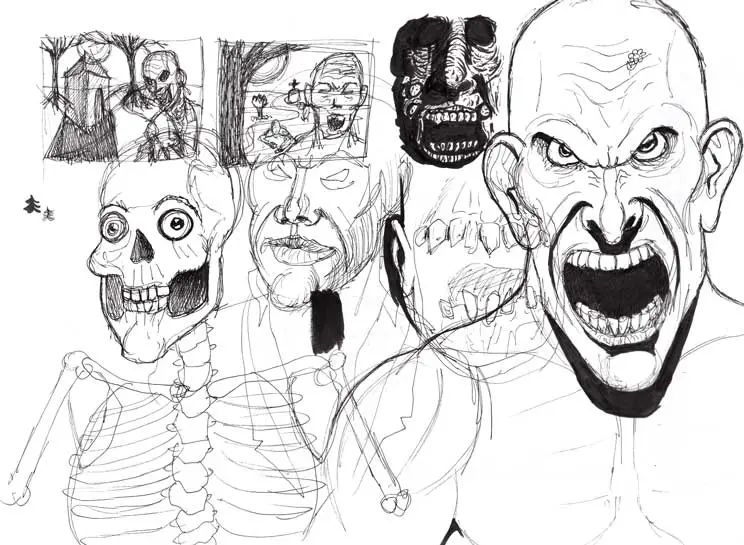
If you want to get better at drawing, you should draw every day. It’s as simple as that.
All too often, drawing can become a thing you do every now and then. For a few weeks, you might draw a couple of days a week… and then you might not touch a pencil at all for a few months.
Unfortunately, you don’t really improve your skills, if you just practice every now and then. Believe me, I speak from experience here, too. You might improve a bit for a few weeks, but you lose much of that new progress after another few weeks of not practicing drawing. It’s like making two steps forward and two steps back.
Especially as a beginner, it’s important to establish a routine. An advanced artist may already draw every day anyway. But a rookie needs to get into the habit of daily drawing.
3. Choose Drawing Or Painting (Lines vs. Shapes)

As a beginner, I think it’s a good idea to decide if you want to focus on drawing or painting.
Drawing and painting are often mentioned in one breath, but they’re fundamentally different. It depends on your definition of those terms, but usually drawings are made up of lines, and paintings are made up of shapes.
Therefore, you have to approach a drawing differently than a painting. You have to think differently. When drawing you think about lines and when painting you think about shapes and values.
(Of course, you can also create a drawing with shapes instead of lines – if you tilt your pencil, for example. But that’s another story.)
Because of this difference, it’s wise to focus on one of the two first, so that you don’t split your focus.
The usual advice is to start with learning to draw. Drawing serves as a good base for painting. It teaches you important basics like construction, proportions, and perspective.
If the preliminary drawing is good, your painting will probably look decent. But if the preliminary drawing is off and full of perspective and proportion mistakes, no amount of color on top will save it.
4. Learn From A Drawing Course
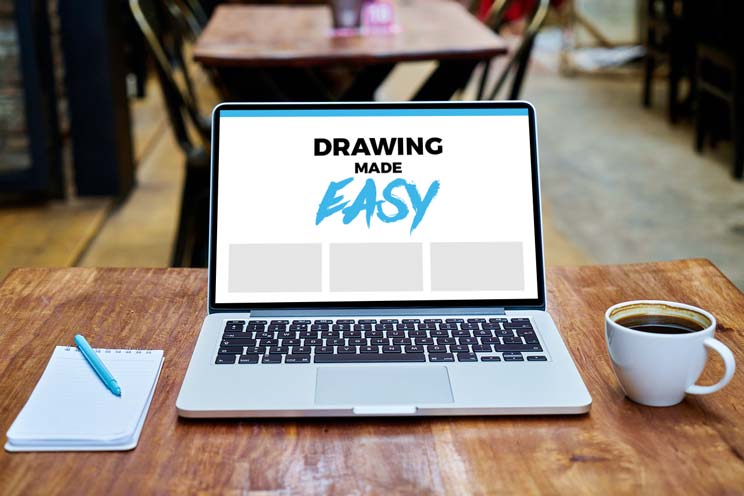
If you’re really motivated and want to improve as fast as possible, it’s a good idea to do a drawing course.
It’s important to create art regularly (see point #2) to immerse yourself in the activity. That way you learn by doing and gain experience quickly.
But consider this quote, too:
„Only a fool learns from his own mistakes. The wise man learns from the mistakes of others.“
-Otto von Bismarck
Drawing courses offer you the possibility to learn a lot of the basics quickly. You can learn from the mistakes and the vast experience of professional artists. Artists who’ve been in the field for decades and can speed up your learning process immensely.
A Great Deal For Drawing Beginners
If you don’t want to spend hours browsing through random articles and videos, you should consider joining Skillshare.
It’s an online course platform with thousands of great courses on drawing and painting.
You can get easy step by step tutorials that teach you drawing from A to Z.
Get 30% OFF Skillshare in your first year:
At the end of this article I will recommend you more courses.
5. Use Reference Images

Let me take a guess: Your goal is to create awesome art from just your imagination, right? That’s probably the ultimate goal of many artists.
The problem is that it’s very hard to put on paper what you imagine in your mind. You need to have deep knowledge of the fundamentals like perspective, light and shadow, and proportions.
When you draw from imagination, your art will only ever be as good as your current skills allow.
The solution is to use reference images. This way you can feed your brain new visual information. Without that, you can only ever reproduce what you already know – which probably isn’t enough. It pretty much never is – you can always learn something new.
Swallow your pride! Using references isn’t cheating. Artists have done it for centuries.
The purpose of reference images isn’t to stop drawing from imagination and just copy everything from now on. Instead, it’s to fill your visual library to improve your ability to draw from imagination (in the long run).
6. Watch Drawing Tutorials

If you are a beginner and want to learn some quick things about drawing and painting, another good idea is to check out YouTube.
YouTube videos are free and often quick to consume. Although they often lack the depth and comprehensiveness of a professional art course, they can teach you a lot of things nevertheless.
Shameless plug:
Have you checked out my YouTube channel yet? It offers a lot of cool videos for beginners, especially in regards to lighting and shading.
Beware though: Don’t fall down the rabbit hole of watching video after video and not drawing at all… I’ve done it often enough.
You think you are getting closer and closer to your goal of becoming an amazing artist by absorbing all this information. But if you’re honest with yourself, you aren’t doing what really improves your skill: drawing!
So watch tutorials – but do so in moderation. Try to apply what you learn.
CHECK OUT: Must-have Art Equipment I Recommend
What Should A Beginner Artist Learn To Draw First?
A beginner artist should learn to draw the fundamentals first. He/She should start by learning to draw simple shapes, and continue by learning 1-point and 2-point perspective. Afterward, he/she can learn lighting and shading and finally concern himself/herself with color.
That’s the way I find most reasonable.
The order and importance of the things you need to learn depends on what you want to draw though.
For more details on that, I recommend my free e-book below:
Improve Faster With My FREE e-Book!

Learn how to MASTER drawing in 5 easy steps with my FREE PDF guide!
Discover a methodical way to learn drawing effectively!
Whatever you decide to do, do yourself a favor:
Focus! Don’t try to learn everything at once. For example, if you want to draw superheroes like I do, don’t draw arms one day, legs the next, and heads the day after. Try to focus on one area for some time and tackle a thing completely.
Of course, you will never be “done”, you can learn something for the rest of your life as an artist (thankfully). But your chances of learning things more quickly will improve a lot, if you learn to focus.
With that said, here is what a beginner should do, ranked by difficulty:
1. Drawing Basic Shapes

After scribbling your first few lines on paper, the first logical step is to start drawing basic shapes.
These basic shapes are ovals, circles, triangles, rectangles, and squares.
Just draw these until you get the shapes right and they don’t look wonky anymore.
You can start by drawing ovals, triangles, and rectangles. These are the easiest because they don’t follow many rules. Next, you can draw circles and squares. The latter are harder than rectangles because every line you draw has to be the same length. Circles are the hardest, so don’t despair! They can even be a challenge for experienced artists!
To add some variety, you can try to draw hexagons, stars, and hearts.
Drawing basic shapes is a great warm-up and you can get the hang of it quickly. If you’ve gotten better and it’s starting to bore you, you can continue with the next step.
2. Drawing Basic Forms
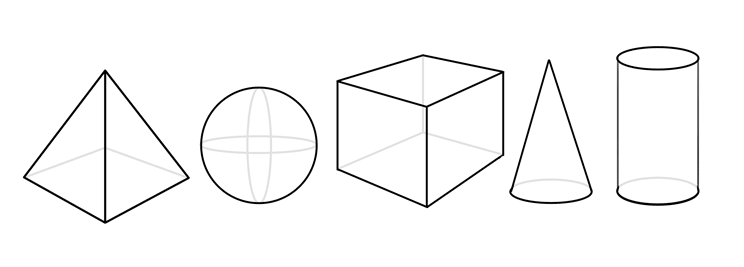
As soon as you can draw basic shapes well, it’s time to add some difficulty.
Basic forms are the basis of more complex and realistic drawings. These are pretty much ovals, circles, triangles, rectangles, and squares – but in 3D.
If you draw them in three dimensions, the forms are spheres, pyramids, cuboids, and cubes. On top of that, there are cones and cylinders.
A little advice from me: Start out with spheres. Step 1: Draw a circle. Done. 🙂
Here is a guide on how to draw basic forms convincingly.
3. Drawing Perspective (1- And 2-Point)
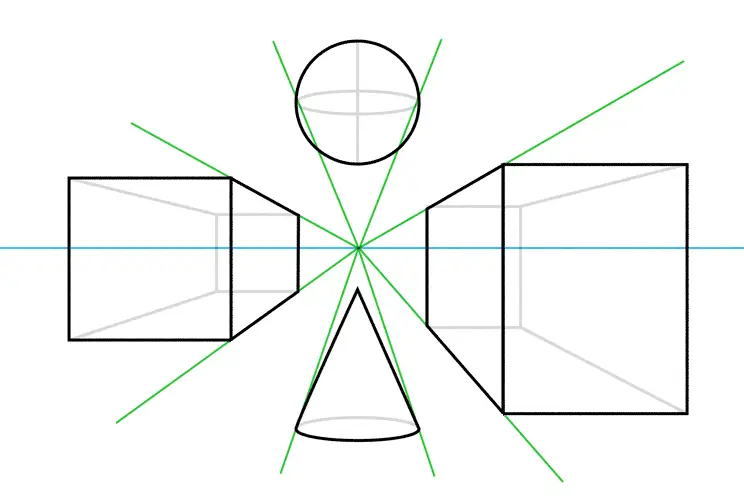
The third fundamental you should learn as a beginner artist is drawing things in a proper perspective. To do this you need to learn 1-point and 2-point perspective.
After you’ve learned to draw basic shapes and then forms, this is the next step: You take the basic forms and draw them in correct perspective. That means, you don’t draw them randomly and separately any longer, but actually place them in a perspectively correct environment.
CHECK OUT: Learn To Draw From Scratch: A Step-By-Step Beginner Guide
This is the base for more realistic and three-dimensional drawings. If you can draw all of the basic forms in perspective, you’re all set. You can basically create any complex form using the basic forms as building blocks.
And at some point, your understanding of perspective gets so great that you can “feel” it. Then, you don’t have to use the basic forms as a guide anymore.
Here’s a funny perspective drawing video for beginners:
4. Values / Lighting

Now that you’ve spent some time with the basics (point #1 to #3), it’s time to introduce values and lighting.
Light and shadow are essential in making a drawing look realistic. They also determine the atmosphere and feeling of a piece of art.
You need to learn everything you can about how light works and how shadows are cast on objects. It’s a complex topic, but the basics can get you a long way. As an artist, you don’t need to understand light on a physics level – a more basic understanding can do the job.
In this step, you focus on values (brightness) only. You practice in grayscale, to simplify things. Color is introduced later.
Check out this helpful video on how to shade basic the forms:
5. Color Theory
Color is the last thing a beginner artist should learn.
Wait, what? The most fun thing comes last? Am I kidding you? What about all those hours before that? Are you supposed to create black and white illustrations only?
No, of course you can experiment with color before that. In the end, color just doesn’t really have that much of an impact on a drawing.
Values are much more impactful than color. A drawing with good values can look great with quite a few color choices. But it doesn’t work the other way round: if your values are off, color alone probably won’t save it.
That said, there will come a time you need to concern yourself with color. Fortunately, the basics of color theory can get you pretty far.
My quick video tutorial on color theory (see above) will give you a crash course.
Good Drawing Courses For Beginner Artists
If you want to learn drawing, but still don’t know where to start, check out these courses, too. They are excellent for beginners and should get you started quickly.
How to Draw From Beginner to Master by Joseph Patric Daniels
Drawing and Shading From Fundamentals to Photorealism
25 Days to Better Drawings by Matt Fussell
The Core Concepts to Drawing – One Day at a Time
Learn to Draw: Daily Practices to Improve Your Drawing Skills by Gabrielle Brickey
Filled with drawing exercises, this course teaches you the basic fundamentals to build your drawing skills.
Conclusion
I hope this article can act as a little roadmap for beginners. If you have any further questions, drop a comment below or shoot me a message.
Have fun drawing!
READ NEXT:
How To Get Great At Drawing Fast: The Best Way To Practice

Thank you for showing lots of great ideas for the beginning artist.
I always advise students just starting to draw that a personal connection
with their subject can make a big difference in the success of the drawing, as well as drawing something enjoyable.
Thanks, Rhonda! Yes, having emotions involved can definitely motivate you to give it your best… and lead to astonishing artworks. 🙂
Thanks Rhonda!
I am going to start as a beginner and your words are very helpful for me and motivate me to get my desired results.
God gives you whatever you want.
thanks
if any pdf for sketching practice you have pls send me in my email if it is not a burden for you, anyway thanks again.
good bye
Why don’t U just add like a course ebook
some of us do not have enough data to watch video’s😟😟
I’m sorry, I don’t know of any really good e-books. Most courses are video courses nowadays. I might create one myself in the future! 🙂